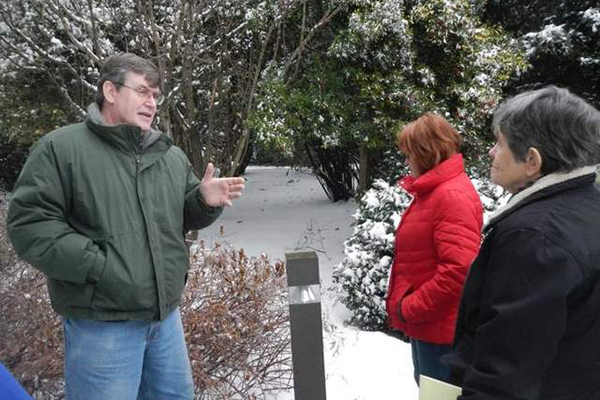
Native Delaware: Awaiting spring
University of Delaware Botanic Gardens offers mini-series on small flowering trees
4:05 p.m., Dec. 6, 2012--It will be four long months before the pink, purple and fuchsia blooms of the Eastern redbud burst forth. Even longer before we’ll see the light pink and white blossoms of serviceberry or the snow white blossoms of native dogwood.
What’s a gardener to do until spring arrives?
Campus Stories
From graduates, faculty
Doctoral hooding
For Catherine Buckminster, of Newark, the answer is simple – learn. “I’ve earned a certificate in ornamental horticulture from Longwood, I take Master Gardener workshops, and, coming up in January, I’m enrolled in a mini-series on small flowering trees offered by the University of Delaware Botanic Gardens,” says Buckminster.
Last year was the first time that the UD Botanic Gardens offered a January lecture series and the response was excellent, says Valann Budishak, volunteer and education coordinator for the gardens.
The beginning of the year can be a hard time for local gardeners, says Budishak. In late fall and early winter, leaves can be raked and composted, fall cutbacks can be completed, and other garden tasks accomplished. By January it’s usually too cold to do outside work while it’s a bit too early to start seeds indoors. The mini-series fills a void for Buckminster and other gardeners who are eager to stay engaged in their hobby.
UD Botanic Gardens Director John Frett teaches the series and he’s designed it so that each of the three lectures stands alone. The series also includes a Saturday lab held in the botanic gardens and UD greenhouses. At that session, he will show off some of the cultivars previously discussed. And, rest assured, there will be plenty to admire, even without a single flower in bloom in the gardens.
“The structure of the trees, shrubs and woody plants are more evident in winter when there are fewer things competing for your attention,” he says.
Like Frett, Buckminster appreciates the form, texture and structure of small flowering trees just as much as the blooms. “People want flowers all season long but most trees are only in bloom a short time,” notes Buckminster, who is a member of the UD Botanic Gardens Friends’ group and a frequent volunteer at the gardens. “I select trees with a nice branching structure – like dogwoods – that are going to look good after the blooms are gone.”
Which is not to say Buckminster doesn’t appreciate a pop of color in the landscape come springtime. Her half-acre Newark yard already has many well-established, larger trees so she is currently developing the understory of smaller shrubs and trees.
“I want a better understory for visual effect, as well as to provide food and shelter for birds,” says Buckminister.
Currently, she has redbuds at the perimeter of her backyard, growing at the edge of woodlands, and dogwoods as specimen plantings throughout the property. She’d like to add some more small, flowering trees in the front, underneath larger trees, to enhance the curb appeal.
At the lecture series, Frett may suggest that she consider the wide variety of magnolias that thrive in Delaware, including native sweetbay magnolia. Like all native magnolias, the sweetbay is a late bloomer – depending on the cultivar, it blooms from May to early summer.
He’ll spend a portion of the Saturday lab session showing off the UD Botanic Gardens’ magnolia collection, which has been expanded to 100 taxa of magnolia, with some 125 magnolias in all. Magnolias are widely scattered throughout the UD gardens but large groupings can be found between Townsend and Worrilow halls, south of Townsend, and also north of UD's outdoor pool.
For those who have very limited space, Frett suggests the M. virginiana “Perry Paige” cultivar of sweetbay – this new dwarf variety tops out at only five to eight feet tall.
Other small flowering trees that Frett will discuss include native serviceberry and hawthorn and native and non-native cherries.
About the series
The UD Botanic Gardens’ small flowering trees mini-series takes place Jan. 9, 16 and 23, from 6:30-8:30 p.m., with a lab on Jan. 19 from 9-11 a.m. Cost for the public is $35 per lecture or lab; if you sign up for all three lectures the lab is free. To register, or for more info, call 831-2531.
Article by Margo McDonough
Photo by Danielle Quigley








